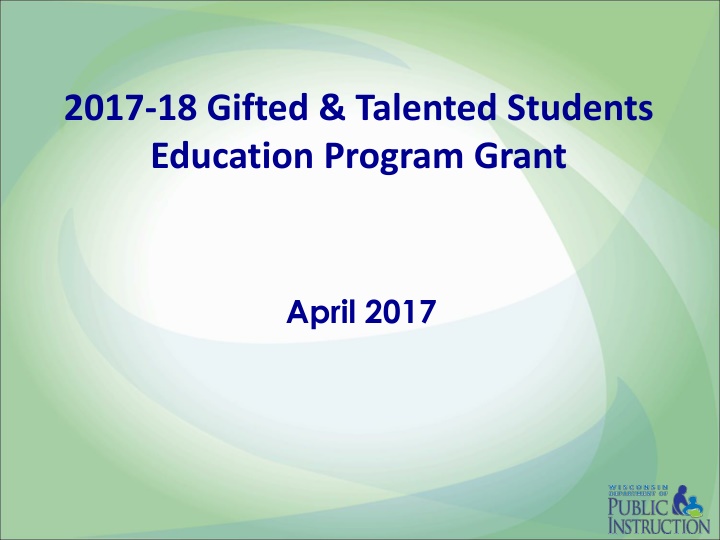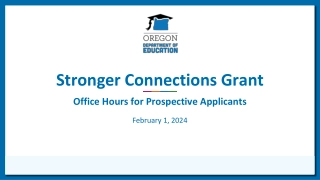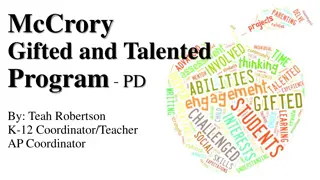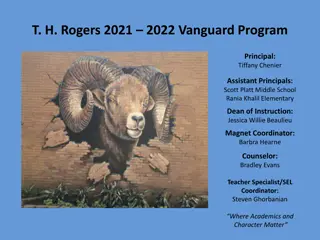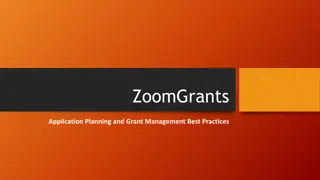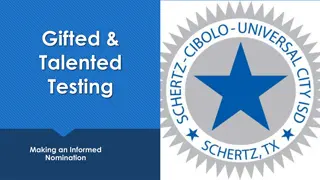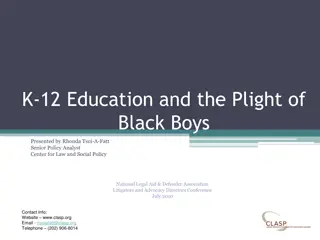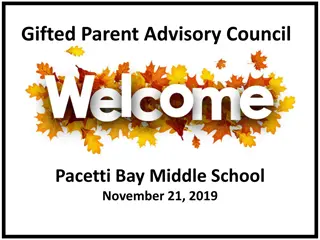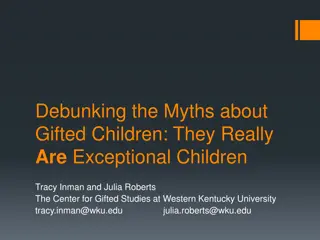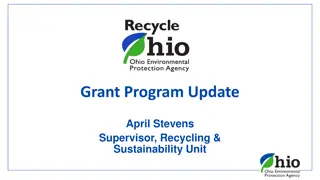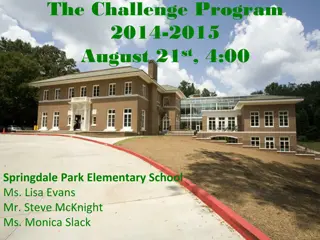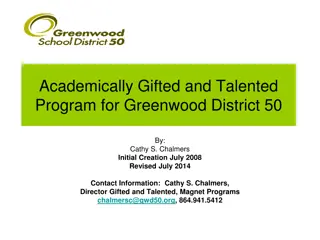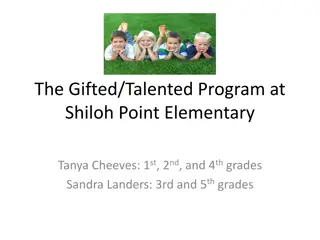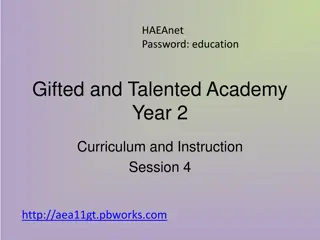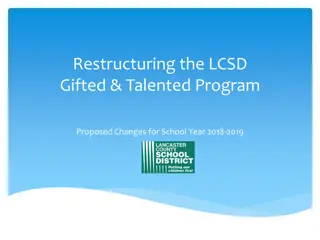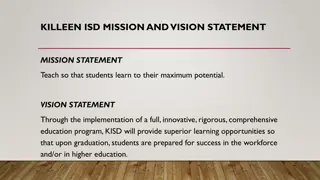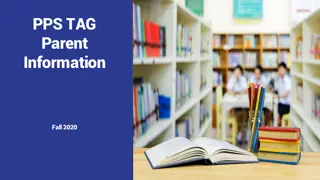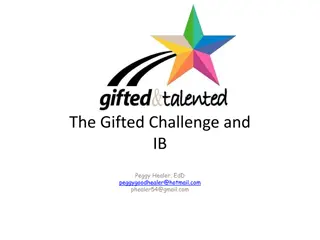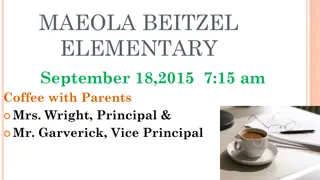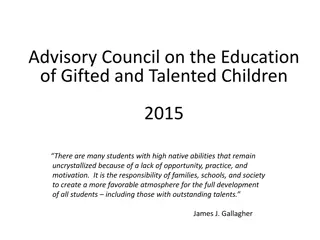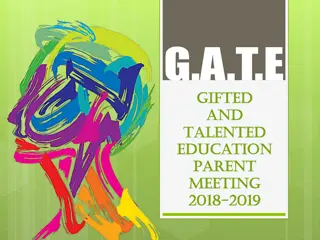2017-18 Grant Program for Gifted and Talented Students
Overview of the 2017-18 Gifted and Talented Education Grant program aimed at providing systematic and continuous learning opportunities for K-12 students with gifts and talents. The grant supports educational needs in areas such as general intellect, specific academic skills, creativity, leadership, and visual/performing arts. Eligible applicants include nonprofit organizations, CESAs, University of Wisconsin institutions, and Milwaukee Public Schools, with a maximum award of $30,000 per applicant. The grant funds activities and services not usually provided in classrooms and emphasizes training for effective delivery. Ineligible activities include administrative costs exceeding 15%, capital purchases, hardware upgrades, weekend/summer programs, and funding for extracurricular activities.
Download Presentation

Please find below an Image/Link to download the presentation.
The content on the website is provided AS IS for your information and personal use only. It may not be sold, licensed, or shared on other websites without obtaining consent from the author.If you encounter any issues during the download, it is possible that the publisher has removed the file from their server.
You are allowed to download the files provided on this website for personal or commercial use, subject to the condition that they are used lawfully. All files are the property of their respective owners.
The content on the website is provided AS IS for your information and personal use only. It may not be sold, licensed, or shared on other websites without obtaining consent from the author.
E N D
Presentation Transcript
2017-18 Gifted & Talented Students Education Program Grant April 2017
Topics Overview of the 2017-18 Gifted and Talented Students Education Grant Components of the Application Narrative Application Review Process Tentative Timeline Application Package and Reviewer Benchmarks
Overview of the 2017-18 Gifted and Talented Education Grant To support systematic and continuous learning opportunities not ordinarily provided in the classroom to meet the educational needs of students with gifts and talents, grades K-12, in the areas of general intellectual, specific academic, creativity, leadership, and the visual and performing arts. Purpose $237,200** **Funding is contingent upon allocations in the State of Wisconsin Biennial Budget Allocation
Overview of the 2017-18 Gifted and Talented Education Grant Eligible Applicants 501(c)(3) Nonprofit Organizations All CESAs Institutions within the University of Wisconsin System Milwaukee Public Schools Maximum Award: $30,000 per applicant
Overview of the 2017-18 Gifted and Talented Education Grant Eligible Activities Systematic and continuous services not ordinarily provided in the classroom for students with gifts and talents Training necessary to provide these services
Overview of the 2017-18 Gifted and Talented Education Grant Ineligible Activities Administrative costs that exceed 15% Capital purchases Computer hardware upgrades or maintenance Weekend or summer programs Funding for co-curricular clubs, competitions, or activities
Narrative Components Abstract Provide a summary of the proposal which describes: Local student needs to be addressed Student outcomes Student learning opportunities Project evaluation
Narrative Components Needs Statement Identify the student needs the proposed project will address: Describe the current local conditions* Describe the desired conditions* State the student needs * Use multiple measures * Attach a summary analysis of the evidence
Narrative Components Needs Statement Two examples: MAP data and information from district common assessments indicate the majority of high ability 3rdgrade students in the region are not meeting grade level expectations to provide reasons to support opinions in written opinion pieces. Student-self assessment on the Leadership Inventory, observation notes from school counselors, and peer feedback reveal middle school students identified for services in leadership do not regularly use rules for collegial discussions.
Narrative Components Student Outcomes and Evidence of Success There are three components to this section: List specific student outcomes. State the expected student growth based on the gaps identified in the Needs Statement. Identify the target goal (rate) of student success. Clearly identify the evidence that will be used to measure to what degree the student outcomes are met.
Narrative Components Student Outcomes and Evidence of Success Two examples: Eighty-five percent of 3rdgrade students participating in the project will improve their ability to support claims with clear reasons and relevant evidence in written opinion pieces by one level on the Project Writing Rubric. Ninety percent of students participating will demonstrate strengthened communication skills by comparing a pre-administration and post-administration of the Leadership Assessment Inventory.
Narrative Components Program Description Describe in detail the student learning opportunities in which students will engage to achieve the student outcomes: What are the learning opportunities? How do they result in the student outcomes? When will the learning opportunities take place? Where will they take place? How are they systematic and continuous (rather than a single event) to lead to student growth? How do they connect to the core curriculum in schools? How do they represent opportunities not available in the regular classroom?
Narrative Components School and Student Participants Name the schools that will participate in the proposed project. Provide the number of students that will participate in each learning opportunity of the proposed project. Describe the process and procedures used to identify these schools and students: - List the identification measures/tools used to identify participating schools and students. - Identify the specific criteria used to select participants. Describe how the process, procedures, tools/measures, and criteria are culturally and linguistically responsive to identify a diverse range of students (i.e., economic conditions, race, gender, culture, native language, developmental differences, and disabilities). Be specific.
Narrative Components Project Implementation Plan Use the form in Section VIII of the application package. Supply details for each of the identified student outcomes and the associated learning opportunities. Include: Estimated costs Detailed timeline Person/position responsible for leadership and implementation
Narrative Components Sustainability Explain how the project will build school capacity to sustain services for students with identified needs for these services.
Narrative Components Evaluation Use Form IX to provide a detailed plan for assessing the degree to which each student outcome was met. Supply the following information for each student outcome (list each student outcome in a separate row) Evidence that will be used to measure to what degree the student outcome was met Methods to analyze evidence Person/position responsible for analyzing evidence
Narrative Components Budget There are two steps to this section: First Then Provide a detailed budget narrative. Clearly indicate how project costs were calculated. Use State Guidelines for expenditures. Complete the Budget Summary Form (Section X of the application package).
Narrative Components Nonprofit Status Attach a copy of the organization s IRS federal tax exemption determination letter. Please note this applies only to 501(c)(3) organizations. CESAs, Milwaukee Public Schools, and institutions within the University of Wisconsin system do not need to submit this documentation
Grant Review Process Office of the State Superintendent External Peer Review Internal Review
Tentative Application Timeline Event Application Deadline Date May 12, 2017 Peer Review June 9, 2017 Acceptance Notification July 1, 2017 Funds Available for Use* Deadline for Project Completion Deadline for Annual Report Deadline for Final Claim * NOTE: Funding is contingent upon allocations in the State of Wisconsin Biennial Budget July 1,2017 June 30, 2018 September 15, 2018 September 30, 2018
Application and Reviewer Benchmarks The 2017-18 Gifted and Talented Students Education Grant application is available on the DPI website: GRANT: http://dpi.wi.gov/sites/default/files/imc e/forms/doc/f9550-iigt.doc
Nancy Anderson, Education Consultant, Gifted and Talented Wisconsin Department of Public Instruction 608-267-9273 nancy.anderson@dpi.wi.gov
